| Listing 1 - 9 of 9 |
Sort by
|
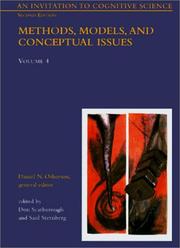
ISBN: 0262650460 026215045X 0262281090 0585053758 9780585053752 9780262281096 0262650452 9780262650458 9780262150453 9780262650465 Year: 1998 Publisher: Cambridge (Mass.) : MIT press,
Abstract | Keywords | Export | Availability | Bookmark
 Loading...
Loading...Choose an application
- Reference Manager
- EndNote
- RefWorks (Direct export to RefWorks)
An Invitation to Cognitive Science provides a point of entry into the vast realm of cognitive science, offering selected examples of issues and theories from many of its subfields. All of the volumes in the second edition contain substantially revised and as well as entirely new chapters.Rather than surveying theories and data in the manner characteristic of many introductory textbooks in the field, An Invitation to Cognitive Science employs a unique case study approach, presenting a focused research topic in some depth and relying on suggested readings to convey the breadth of views and results. Each chapter tells a coherent scientific story, whether developing themes and ideas or describing a particular model and exploring its implications.The volumes are self contained and can be used individually in upper-level undergraduate and graduate courses ranging from introductory psychology, linguistics, cognitive science, and decision sciences, to social psychology, philosophy of mind, rationality, language, and vision science.
Cognitive psychology --- #PBIB:1998.3 --- Cognition. --- Psychology --- Cognitive science. --- NEUROSCIENCE/Visual Neuroscience --- COGNITIVE SCIENCES/General --- Science --- Philosophy of mind
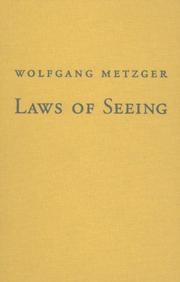
ISBN: 0262134675 9780262134675 9780262513364 9780262279710 0262279711 9781429477604 1429477601 0262513366 0262311704 1282098322 9786612098321 Year: 2006 Publisher: Cambridge, Mass. MIT
Abstract | Keywords | Export | Availability | Bookmark
 Loading...
Loading...Choose an application
- Reference Manager
- EndNote
- RefWorks (Direct export to RefWorks)
The first English translation of a classic work in vision science from 1936 by a leading figure in the Gestalt movement, covering topics that continue to be major issues in vision research today.This classic work in vision science, written by a leading figure in Germany's Gestalt movement in psychology and first published in 1936, addresses topics that remain of major interest to vision researchers today. Wolfgang Metzger's main argument, drawn from Gestalt theory, is that the objects we perceive in visual experience are not the objects themselves but perceptual effigies of those objects constructed by our brain according to natural rules. Gestalt concepts are currently being increasingly integrated into mainstream neuroscience by researchers proposing network processing beyond the classical receptive field. Metzger's discussion of such topics as ambiguous figures, hidden forms, camouflage, shadows and depth, and three-dimensional representations in paintings will interest anyone working in the field of vision and perception, including psychologists, biologists, neurophysiologists, and researchers in computational vision―and artists, designers, and philosophers.Each chapter is accompanied by compelling visual demonstrations of the phenomena described; the book includes 194 illustrations, drawn from visual science, art, and everyday experience, that invite readers to verify Metzger's observations for themselves. Today's researchers may find themselves pondering the intriguing question of what effect Metzger's theories might have had on vision research if Laws of Seeing and its treasure trove of perceptual observations had been available to the English-speaking world at the time of its writing.
Book
ISBN: 0262319896 0262027852 1322294054 026231990X 9780262319898 9780262027854 Year: 2014 Publisher: Cambridge, Mass. The MIT Press
Abstract | Keywords | Export | Availability | Bookmark
 Loading...
Loading...Choose an application
- Reference Manager
- EndNote
- RefWorks (Direct export to RefWorks)
Cutting-edge research on the visual cognition of scenes, covering issues that include spatial vision, context, emotion, attention, memory, and neural mechanisms underlying scene representation.
Visual perception. --- Vision. --- Eyesight --- Seeing --- Sight --- Optics, Psychological --- Vision --- Psychological aspects --- Senses and sensation --- Blindfolds --- Eye --- Physiological optics --- Perception --- Visual discrimination --- NEUROSCIENCE/Visual Neuroscience --- NEUROSCIENCE/General --- Philosophical anthropology --- Physiology of nerves and sense organs
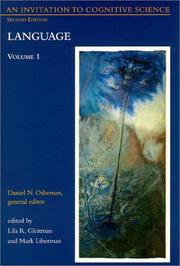
ISBN: 0262150441 0262650444 0262650452 0262273918 0585027773 9780585027777 0585003122 9780585003122 0585053456 9780585053455 0585053758 9780585053752 9780262273916 9780262277495 0262277492 9780262283922 0262283921 9780262281096 0262281090 9780262650458 0262150433 9780262150439 0262650436 9780262650434 9780262150446 9780262650441 0262650428 9780262650427 0262150425 9780262150422 026215045X 9780262150453 0262650460 9780262650465 0262650347 9780262650342 Year: 1995 Publisher: Cambridge, Mass. MIT
Abstract | Keywords | Export | Availability | Bookmark
 Loading...
Loading...Choose an application
- Reference Manager
- EndNote
- RefWorks (Direct export to RefWorks)
An Invitation to Cognitive Science provides a point of entry into the vast realm of cognitive science, offering selected examples of issues and theories from many of its subfields. All of the volumes in the second edition contain substantially revised and as well as entirely new chapters.Rather than surveying theories and data in the manner characteristic of many introductory textbooks in the field, An Invitation to Cognitive Science employs a unique case study approach, presenting a focused research topic in some depth and relying on suggested readings to convey the breadth of views and results. Each chapter tells a coherent scientific story, whether developing themes and ideas or describing a particular model and exploring its implications.The volumes are self contained and can be used individually in upper-level undergraduate and graduate courses ranging from introductory psychology, linguistics, cognitive science, and decision sciences, to social psychology, philosophy of mind, rationality, language, and vision science.
Psycholinguistics --- Cognitive psychology --- #SBIB:309H505 --- #SBIB:AANKOOP --- Code en boodschap: psychologische, psycho-analytische benadering --- Language and languages. --- Cognition. --- Psycholinguistics. --- COGNITIVE SCIENCES/General --- Psychology --- Language, Psychology of --- Language and languages --- Psychology of language --- Speech --- Linguistics --- Thought and thinking --- Foreign languages --- Languages --- Anthropology --- Communication --- Ethnology --- Information theory --- Meaning (Psychology) --- Philology --- Psychological aspects --- Cognition --- Cognitive science. --- NEUROSCIENCE/Visual Neuroscience --- Science --- Philosophy of mind --- Cognitive science
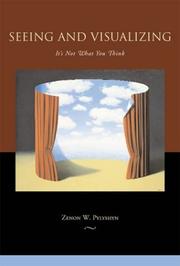
ISBN: 0262162172 0262661977 0262316315 9780262316316 9780262162173 9780262661973 Year: 2006 Publisher: Cambridge, Mass.: MIT Press,
Abstract | Keywords | Export | Availability | Bookmark
 Loading...
Loading...Choose an application
- Reference Manager
- EndNote
- RefWorks (Direct export to RefWorks)
In Seeing and Visualizing, Zenon Pylyshyn argues that seeing is different from thinking and that to see is not, as it may seem intuitively, to create an inner replica of the world. Pylyshyn examines how we see and how we visualize and why the scientific account does not align with the way these processes seem to us "from the inside." In doing so, he addresses issues in vision science, cognitive psychology, philosophy of mind, and cognitive neuroscience. First, Pylyshyn argues that there is a core stage of vision independent from the influence of our prior beliefs and examines how vision can be intelligent and yet essentially knowledge-free. He then proposes that a mechanism within the vision module, called a visual index (or FINST), provides a direct preconceptual connection between parts of visual representations and things in the world, and he presents various experiments that illustrate the operation of this mechanism. He argues that such a deictic reference mechanism is needed to account for many properties of vision, including how mental images attain their apparent spatial character without themselves being laid out in space in our brains. The final section of the book examines the "picture theory" of mental imagery, including recent neuroscience evidence, and asks whether any current evidence speaks to the issue of the format of mental images. This analysis of mental imagery brings together many of the themes raised throughout the book and provides a framework for considering such issues as the distinction between the form and the content of representations, the role of vision in thought, and the relation between behavioral, neuroscientific, and phenomenological evidence regarding mental representations.Review: Pylyshyn's book is to be commended as a thorough and persuasive defense of the information-processing approach to vision and visualizing. It should be essential reading for psychologists, cognitive scientists, and philosophers
Cognitive psychology --- Philosophical anthropology --- Categorization (Psychology) --- Cognitive science --- Mental representation --- Recognition (Psychology) --- Visual perception --- Visualization --- Visualisation --- Imagery (Psychology) --- Imagination --- Optics, Psychological --- Vision --- Perception --- Visual discrimination --- Memory --- Representation, Mental --- Abstraction --- Science --- Philosophy of mind --- Classification (Psychology) --- Psychological aspects --- Visualization. --- Perception visuelle. --- Visualisation. --- Représentation mentale. --- Recognition (psychologie) --- Catégorisation (psychologie) --- Visual perception. --- Mental representation. --- Cognitive science. --- COGNITIVE SCIENCES/General --- NEUROSCIENCE/Visual Neuroscience
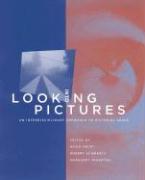
ISBN: 0262083108 0262275163 0585481067 9780262275163 9780585481067 9780262083102 Year: 2003 Publisher: Cambridge, Mass. MIT
Abstract | Keywords | Export | Availability | Bookmark
 Loading...
Loading...Choose an application
- Reference Manager
- EndNote
- RefWorks (Direct export to RefWorks)
Annotation
Cognitive psychology --- Theory of knowledge --- Picture perception --- Perspective --- Picture interpretation --- Psychology --- Social Sciences --- Edited by Heiko Hecht, Robert Schwartz, Margaret Atherton --- kunst --- twintigste eeuw --- kunsttheorie --- schilderkunst --- beeldhouwkunst --- perceptie --- perspectief --- tekenkunst --- ruimte --- optica --- 7.01 --- -Perspective --- -Picture interpretation --- -152.14 --- Interpretation of pictures --- Architectural perspective --- Linear perspective --- Mechanical perspective --- Optics --- Space (Art) --- Space perception --- Projection --- Proportion (Art) --- Shades and shadows --- Form perception --- Perception --- Visual perception --- COGNITIVE SCIENCES/General --- NEUROSCIENCE/Visual Neuroscience --- 152.14
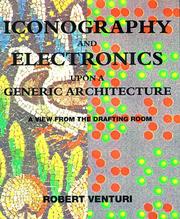
ISBN: 0262220512 0262285355 0585360278 Year: 1996 Publisher: Cambridge, Mass. MIT
Abstract | Keywords | Export | Availability | Bookmark
 Loading...
Loading...Choose an application
- Reference Manager
- EndNote
- RefWorks (Direct export to RefWorks)
In this book, Shimon Ullman focuses on the processes of high-level vision that deal with the interpretation and use of what is seen in the image. In particular, he examines two major problems. The first, object recognition and classification, involves recognizing objects despite large variations in appearance caused by changes in viewing position, illumination, occlusion, and object shape. The second, visual cognition, involves the extraction of shape properties and spatial relations in the course of performing visual tasks such as object manipulation, planning movements in the environment, or interpreting graphical material such as diagrams, graphs and maps. The book first takes up object recognition and develops a novel approach to the recognition of three-dimensional objects. It then studies a number of related issues in high-level vision, including object classification, scene segmentation, and visual cognition. Using computational considerations discussed throughout the book, along with psychophysical and biological data, the final chapter proposes a model for the general flow of information in the visual cortex. Understanding vision is a key problem in the brain sciences, human cognition, and artificial intelligence. Because of the interdisciplinary nature of the theories developed in this work, High-Level Vision will be of interest to readers in all three of these fields.
architectuurtheorie --- Architecture --- architectural theory --- anno 1900-1999 --- Architecture, Modern --- Philosophy --- Philosophie --- Robert Venturi °1925 (°Philadelphia) --- Architectuurtheorie ; 20ste eeuw ; R. Venturi --- Architectuur ; iconologie ; betekenis --- 72.01 --- Architectuur ; theorie, filosofie, esthetica --- History --- Visual perception. --- NEUROSCIENCE/Visual Neuroscience --- COGNITIVE SCIENCES/General --- 72.07 --- Venturi, Robert 1925-2018 (°Philadelphia, Verenigde Staten) --- Architecten. Stedenbouwkundigen --- Optics, Psychological --- Vision --- Perception --- Visual discrimination --- Psychological aspects --- Form perception. --- Form discrimination --- Shape discrimination --- Shape perception --- Visual perception --- Figure-ground perception
Book
ISBN: 0262535092 0262346281 9780262346283 9780262346290 026234629X 9780262535090 Year: 2018 Publisher: Cambridge, Massachusetts : The MIT Press,
Abstract | Keywords | Export | Availability | Bookmark
 Loading...
Loading...Choose an application
- Reference Manager
- EndNote
- RefWorks (Direct export to RefWorks)
An accessible, concise primer on the neurological trait of synesthesia?vividly felt sensory couplings?by a founder of the field. One in twenty-three people carry the genes for the synesthesia. Not a disorder but a neurological trait?like perfect pitch?synesthesia creates vividly felt cross-sensory couplings. A synesthete might hear a voice and at the same time see it as a color or shape, taste its distinctive flavor, or feel it as a physical touch. In this volume in the MIT Press Essential Knowledge series, Richard Cytowic, the expert who returned synesthesia to mainstream science after decades of oblivion, offers a concise, accessible primer on this fascinating human experience. Cytowic explains that synesthesia's most frequent manifestation is seeing days of the week as colored, followed by sensing letters, numerals, and punctuation marks in different hues even when printed in black. Other manifestations include tasting food in shapes, seeing music in moving colors, and mapping numbers and other sequences spatially. One synesthete declares,?Chocolate smells pink and sparkly?; another invents a dish (chicken, vanilla ice cream, and orange juice concentrate) that tastes intensely blue. Cytowic, who in the 1980s revived scientific interest in synesthesia, sees it now understood as a spectrum, an umbrella term that covers five clusters of outwardly felt couplings that can occur via several pathways. Yet synesthetic or not, each brain uniquely filters what it perceives. Cytowic reminds us that each individual's perspective on the world is thoroughly subjective.
Cognitive psychology --- Physiology of nerves and sense organs --- synesthesia --- Synesthesia --- Perceptual disorders --- Perceptual Disorders --- Perceptual Distortion --- Hemisensory Neglect --- Sensory Neglect --- Somatosensory Discrimination Disorder --- Hemispatial Neglect --- Discrimination Disorder, Somatosensory --- Discrimination Disorders, Somatosensory --- Hemisensory Neglects --- Hemispatial Neglects --- Neglect, Hemisensory --- Neglect, Hemispatial --- Neglect, Sensory --- Neglects, Hemisensory --- Perceptual Disorder --- Sensory Neglects --- Somatosensory Discrimination Disorders --- Disabilities --- Nervous system --- Psychology, Pathological --- Disorders of perception --- Perception, Disorders of --- Perception disorders --- Perceptual disturbances --- Perceptual dysfunction --- Intersensory effects --- Psychology --- Senses and sensation --- Color-hearing --- Sound symbolism --- Synaesthesia --- Diseases --- Synesthesia. --- COGNITIVE SCIENCES/Cognitive Neuroscience --- NEUROSCIENCE/Visual Neuroscience --- BIOMEDICAL SCIENCES/Medicine
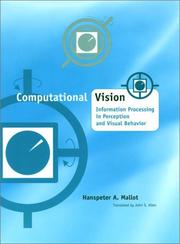
ISBN: 0262133814 0262278952 1423727525 9780262278959 9780262133814 Year: 2000 Publisher: Cambridge, Mass. MIT
Abstract | Keywords | Export | Availability | Bookmark
 Loading...
Loading...Choose an application
- Reference Manager
- EndNote
- RefWorks (Direct export to RefWorks)
This text provides an introduction to computational aspects of early vision, in particular, color, stereo, and visual navigation. It integrates approaches from psychophysics and quantitative neurobiology, as well as theories and algorithms from machine vision and photogrammetry. When presenting mathematical material, it uses detailed verbal descriptions and illustrations to clarify complex points. The text is suitable for upper-level students in neuroscience, biology, and psychology who have basic mathematical skills and are interested in studying the mathematical modeling of perception.
Artificial intelligence. Robotics. Simulation. Graphics --- Affective and dynamic functions --- Physiology of nerves and sense organs --- Vision --- Computational neuroscience --- Visual cortex --- Neurosciences informatiques --- Computer simulation --- Models, Biological --- Perception --- Models, Theoretical --- Mental Processes --- Investigative Techniques --- Psychological Phenomena and Processes --- Analytical, Diagnostic and Therapeutic Techniques and Equipment --- Psychiatry and Psychology --- Models, Neurological --- Visual Perception --- Human Anatomy & Physiology --- Health & Biological Sciences --- Neuroscience --- Perception, Visual --- Perceptions, Visual --- Visual Perceptions --- Model, Neurological --- Neurologic Model --- Neurological Model --- Neurological Models --- Neurologic Models --- Model, Neurologic --- Models, Neurologic --- Psychologic Processes and Principles --- Investigative Technics --- Investigative Technic --- Investigative Technique --- Technic, Investigative --- Technics, Investigative --- Technique, Investigative --- Techniques, Investigative --- Human Information Processing --- Information Processing, Human --- Experimental Model --- Experimental Models --- Mathematical Model --- Model, Experimental --- Models (Theoretical) --- Models, Experimental --- Models, Theoretic --- Theoretical Study --- Mathematical Models --- Model (Theoretical) --- Model, Mathematical --- Model, Theoretical --- Models, Mathematical --- Studies, Theoretical --- Study, Theoretical --- Theoretical Model --- Theoretical Models --- Theoretical Studies --- Perceptions --- Biological Model --- Biological Models --- Model, Biological --- Models, Biologic --- Biologic Model --- Biologic Models --- Model, Biologic --- Vision, Ocular --- Psychologic Processes --- Psychological Processes --- Phenomena, Psychological --- Processes, Psychologic --- Processes, Psychological --- Psychological Phenomenas --- Psychological Processe --- Computer Simulation --- Systems Theory --- Sensation --- Computational neuroscience. --- Computer simulation. --- NEUROSCIENCE/General --- NEUROSCIENCE/Visual Neuroscience --- Eyesight --- Seeing --- Sight --- Senses and sensation --- Blindfolds --- Eye --- Physiological optics --- Area striata --- Striate area --- Striate cortex --- Occipital lobes --- Computational neurosciences --- Computational biology --- Neurosciences
| Listing 1 - 9 of 9 |
Sort by
|

 Search
Search Feedback
Feedback About UniCat
About UniCat  Help
Help News
News